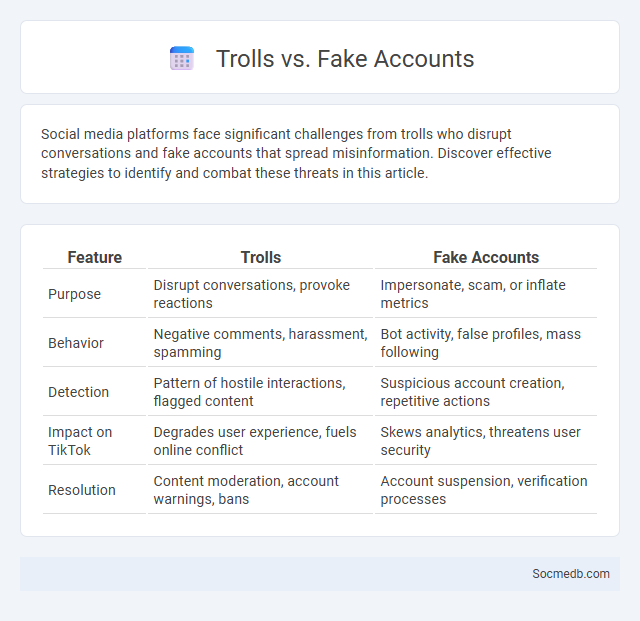
Photo illustration: Trolls vs Fake Accounts
Social media platforms face significant challenges from trolls who disrupt conversations and fake accounts that spread misinformation. Discover effective strategies to identify and combat these threats in this article.
Table of Comparison
| Feature | Trolls | Fake Accounts |
|---|---|---|
| Purpose | Disrupt conversations, provoke reactions | Impersonate, scam, or inflate metrics |
| Behavior | Negative comments, harassment, spamming | Bot activity, false profiles, mass following |
| Detection | Pattern of hostile interactions, flagged content | Suspicious account creation, repetitive actions |
| Impact on TikTok | Degrades user experience, fuels online conflict | Skews analytics, threatens user security |
| Resolution | Content moderation, account warnings, bans | Account suspension, verification processes |
Understanding Trolls: Definition and Motivations
Trolls on social media are individuals who deliberately post inflammatory or provocative content to disrupt discussions and elicit strong emotional responses. Their motivations often stem from a desire for attention, amusement, or to spread misinformation and create conflict within online communities. Recognizing troll behavior helps users and platforms implement strategies to minimize their impact and maintain constructive digital interactions.
What Are Fake Accounts? Characteristics and Purposes
Fake accounts on social media are profiles created using false information, often lacking personal details or displaying generic images, designed to mislead users. These accounts commonly engage in activities such as spreading misinformation, inflating follower counts, or conducting scams to manipulate public opinion or gain financial benefits. Understanding these characteristics helps you identify and avoid interactions with fake profiles that could compromise your online experience.
Key Differences: Trolls vs Fake Accounts
Trolls engage in social media by deliberately provoking and harassing users to incite emotional responses and discord, often using inflammatory language or controversial topics. Fake accounts are created to impersonate real individuals or organizations, frequently aimed at spreading misinformation, scamming, or manipulating online perceptions. Protecting Your social media experience requires identifying trolls through their aggressive behavior patterns, while spotting fake accounts often involves scrutinizing profile authenticity and activity consistency.
Overlapping Behaviors: When Trolls Use Fake Accounts
Trolls exploit fake accounts to amplify disruptive behaviors across social media platforms, creating overlapping patterns of harassment and misinformation that are difficult to trace. These coordinated actions often involve multiple fake profiles engaging simultaneously to manipulate public opinion and evade detection algorithms. Understanding the dynamics of these overlapping behaviors is crucial for developing robust moderation strategies and improving platform security.
Psychological Impact: Trolls and Fake Profiles Online
Trolls and fake profiles on social media significantly affect your psychological well-being by fostering anxiety, mistrust, and emotional distress. Exposure to harassment and misinformation can lead to decreased self-esteem and heightened feelings of isolation. Protecting your mental health involves recognizing these harmful behaviors and implementing privacy settings to limit their influence.
Detecting Trolls in Online Communities
Detecting trolls in online communities involves analyzing user behavior patterns such as repeated inflammatory comments, off-topic posts, and provocative language designed to disrupt discussions. Advanced algorithms and machine learning tools can identify these patterns by monitoring frequency, sentiment, and engagement metrics to flag potential trolls. Protecting your online community enhances user experience and fosters healthy interactions by minimizing toxic behavior and promoting constructive conversations.
Spotting Fake Accounts: Red Flags to Watch For
Identifying fake social media accounts often involves spotting inconsistent profile information, unusual activity patterns, and generic or stolen profile images. Your vigilance in detecting these red flags, such as sudden follower surges or repeated spam-like posts, can protect your online interactions from scams and misinformation. Prioritizing account verification and cross-referencing user details enhances your ability to maintain a secure social media environment.
Social Media Platforms’ Response to Trolls and Fakes
Social media platforms employ advanced AI algorithms and human moderators to detect and remove troll accounts and fake profiles rapidly, thereby minimizing misinformation spread and harmful interactions. Features like user reporting systems, content filtering, and verification badges are implemented to enhance platform integrity and user trust. Constantly evolving policies target coordinated disinformation campaigns and automated bots to maintain authentic online communities.
Consequences: The Real-World Impact of Internet Trolls and Fake Accounts
Internet trolls and fake accounts significantly distort online discourse, spreading misinformation and fostering hostility across social media platforms like Facebook, Twitter, and Instagram. These malicious activities undermine public trust, disrupt democratic processes, and contribute to mental health issues by amplifying cyberbullying and harassment. The real-world consequences include increased polarization, damaged reputations, and challenges in identifying credible information in digital communication ecosystems.
Strategies for Combating Trolls and Fake Accounts Online
Effective strategies for combating trolls and fake accounts online include utilizing advanced AI algorithms to detect and block suspicious behaviors, implementing multi-factor authentication to verify user identities, and promoting community guidelines that encourage respectful interactions. You can enhance your online experience by reporting abusive content promptly and engaging with platforms that prioritize transparency and swift moderation. Leveraging these tactics helps create a safer and more authentic social media environment.
 socmedb.com
socmedb.com